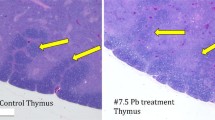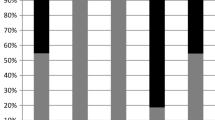Abstract
The effects of diet and cold exposure on captive female mourning doves (Zenaida macroura) dosed with lead (Pb) shot were investigated from 12 December 1985 to 2 January 1986. Doves were screened for Pb exposure using a blood delta-aminolevulinic acid dehydratase assay. A 2×2× 2 factorial design was employed with Pb (1 #8 Pb shot {70±0.5 mg} or seed), temperature (5°C or 22°C), and diet (commercial pelleted ration or mixed seed) as the three factors of interest. Ninetysix doves were assigned randomly to 1 of the 8 treatments, confined individually, and acclimated to their respective diets 3 weeks prior to dosing.
No mortality occurred during the experiment. Changes in body weight after 2 and 3 weeks did not differ between Pb-treated doves and controls. Tissue Pb concentrations were higher in Pb-dosed birds than controls. Partially eroded Pb shot were recovered from feces in 89% (39/44) of the Pb-dosed doves. Doves on the pelleted diet retained Pb shot longer and eroded more Pb than did doves on the mixed seed diet. Tissue Pb concentrations, especially in the kidney, were higher in Pb-treated birds on the mixed seed diet. There were no differences in tissue Pb concentrations due to temperature although there was a diet × temperature interaction in kidney Pb concentrations of Pb-treated doves. The increased likelihood of shot expulsion on the mixed seed diet was apparently offset by nutritional and/or other factors which increased Pb absorption and/or retention in body tissues.
Similar content being viewed by others
References
Anderson L, Havera SP (1985) Blood lead, protoporphyrin and ingested shot for detecting Pb poisoning in waterfowl. Wildl Soc Bull 13:26–31
Bagley GE, Locke LN (1967) The occurrence of lead in tissues of wild birds. Bull Environ Contain Toxicol 2:197–305.
Barton JC, Conrad ME, Harrison L, Nuby S (1978) Effects of calcium on the absorption and retention of lead. J Lab Clin Med 91:366–376
Bellrose FC (1959) Lead poisoning as a mortality factor in waterfowl populations. Ill Nat Hist Surv Bull 27:235–288
Buerger TT, Mirarchi RE, Lisano ME (1986) Effects of lead shot ingestion on captive mourning dove survivability and reproduction. J Wildl Manage 50:1–8
Buerger TT, Muller LI, Mirarchi RE, Lisano ME (1983) Lead shot ingestion in a sample of Alabama mourning doves. J Ala Acad Sci 54:119
Carlson BL, Nielson SW (1985) Influence of dietary calcium on lead poisoning in mallard ducks (Anas platyrhynchos). Am J Vet Res 46:276–282
Chasko GG, Hoehn TR, Howeu-Heller P (1984) Toxicity of lead shot to wild black ducks and mallards fed natural foods. Bull Environ Contam Toxicol 32:417–428
Clemens ET, Krook L, Aronson AL, Stevens CE (1975) Pathogenesis of lead shot poisoning in the mallard duck. Cornell Vet 65:248–285
Finley MT, Dieter MP (1978) Toxicity of experimental lead-iron shot versus commercial lead shot in mallards. J Wildl Manage 42:32–39
Fullmer CS, Edelstein S, Wasserman RH (1985) Lead-binding properties of intestinal calcium-binding proteins. J Biol Chem 260:6816–6819
George AL III (1987) Effects of lead shot ingestion on several blood parameters in mourning doves. MS Thesis, Auburn University, Auburn, AL, 50 pp
Godin AJ (1967) Test of grit types in alleviating lead poisoning in mallards. US Fish and Wildl Serv Spec Sci Rep—Wildl 107. Washington, DC, 9 pp
Goyer RA (1978) Calcium and lead interactions: some new insights. J Lab Clin Med 91:363–365
Granick S, Sassa S, Granick JL, Levere RD, Kappas A (1972) Assays for porphyrins, Δ-aminolevulinic acid dehydratase, and porphyrinogen synthetase in microliter samples of whole blood; applications to metabolic defects involving the heme pathway. Proc Nat Acad Sci 69:2381–2385
Ivacic DL, Labisky RF (1973) Metabolic responses of mourning doves to short-term food and temperature stresses in winter. Wilson Bull 85:182–196
Jordan JS (1968) Influence of diet on lead poisoning in waterfowl. Trans NE Sec The Wildl Soc Conf 25:143–170
Jordan JS, Bellrose FC (1950) Shot alloys and lead poisoning in waterfowl. Trans N Am Wildl Conf 15:155–170
Kendall RJ, Scanion PF (1979) Lead concentrations in mourning doves collected from middle Atlantic game management areas. Proc Ann Conf SE Assoc Fish and Wildl Agencies 33:165–172
— (1982) Tissue lead concentrations and blood characteristics of mourning doves from southwestern Virginia. Arch Environ Contam Toxicol 11:269–272
— (1984) The toxicology of lead shot ingestion in ringed turtle doves under conditions of cold exposure. J Environ Pathol Toxicol Oncol 5:183–192
Kendall RJ, Di Giulio RT (1982) Toxicology of ingested lead shot in ringed turtle doves. Arch Environ Contam Toxicol 11:259–263
Kendall RJ, Scanion PF, Veit HP (1983) Histologic and ultrastructural lesions of mourning doves (Zenaida macroura) poisoned by lead shot. Poult Sci 62:952–959
Lewis JC, Legler E Jr (1968) Lead shot ingestion by mourning doves and incidence in soil. J Wildl Manage 32:476–482
Locke LN, Bagley GE (1967) Lead poisoning in a sample of Maryland mourning doves. J Wildl Manage 31:515–518
Longcore JR, Andrews R, Locke LN, Bagley GE (1974a) Toxicity of lead and proposed substitute shot to mallards. US Fish and Wildl Serv Spec Sci Rep—Wildl 183, Washington, DC 23 pp
Longcore JT, Locke N, Bagley GE, Andrews R (1974b) Significance of lead residues in mallard tissues. US Fish and Wildl Serv Spec Sci Rep—Wildl 182, Washington, DC, 24 pp
Mahaffey KR, Michaelson IA (1980) The interaction between lead and nutrition. In: Needleman HL (ed) Low level lead exposure: The clinical implications of current research. Raven Press, New York, pp 159–200
McConnell CA (1967) Experimental lead poisoning of bobwhite quail and mourning doves. Proc Ann Conf SE Assoc Game Fish Comm 21:208–219
Sanderson GC, Bellrose FC (1986) A review of the problem of lead poisoning in waterfowl. Ill Natl Hist Survey Special Publication 4, Urbana, IL, 34 pp
Sanderson GC, Norton HW, Hurley SS (1981) Effects of ingested Pb-Iron shot on mallards. Ill Nat Hist Survey Biol Notes No 116, Urbana, IL, 15 pp
SAS Institute Inc (1982a) SAS user's guide: Basics, 1982 edition. SAS Inst Inc, Cary, NC, 921 pp
— (1982b) SAS user's guide: Statistics, 1982 edition. SAS Inst Inc, Cary, NC, 584 pp
Scanlon PF, Stotts VD, Oderwald RG, Dietrick TJ, Kendall RJ. (1980) Lead concentrations in livers of Maryland waterfowl with and without ingested lead shot present in gizzards. Bull Environ Contam Toxicol 25:855–860
Seibert HC (1949) Differences between migrant and non-migrant birds in food and water intake at various temperatures and photoperiods. Auk 66:128–153
Shields JB, Mitchell HH (1941) The effect of calcium and phosphorus on the metabolism of lead. J Nutri 21:541–552
Six KM, Goyer RA (1970) Experimental enhancement of lead toxicity by low dietary calcium. J Lab Clin Med 76:933–942
Trost RE (1981) Dynamics of grit selection and retention in captive mallards. J Wildl Manage 45:64–73
Author information
Authors and Affiliations
Rights and permissions
About this article
Cite this article
Marn, C.M., Mirarchi, R.E. & Lisano, M.E. Effects of diet and cold exposure on captive female mourning doves dosed with lead shot. Arch. Environ. Contam. Toxicol. 17, 589–594 (1988). https://doi.org/10.1007/BF01055827
Received:
Revised:
Issue Date:
DOI: https://doi.org/10.1007/BF01055827




